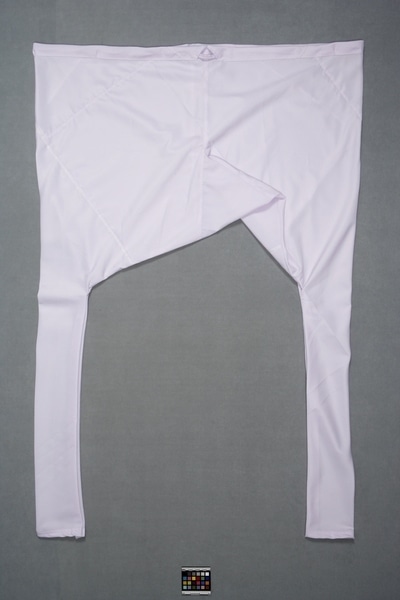Pants Item Number: 2615/3 from the MOA: University of British Columbia


Description
Machine-sewn man's lavender coloured pants. Wide drawstring waist and relaxed area around the hips and groin. Elongated and fitted legs.
History Of Use
Pants of this type were commonly worn by men of the Koli caste in Dhamlej Village as of 1999. The pants were worn as a set with a shirt, either in Indian or western style, of matching fabric, as well as with a turban. Members of that caste assisted in the production and gathering of this clothing. The cloth for the clothing was purchased in Kodinar town, 7 km. to the east of Dhamlej, and they were sewn in Dhamlej by Lakmanbbhai Chavada, a tailor in the agricultural area of the village. Such shirts were also worn by men of the Hindu Rabari caste. Younger male villagers preferred, however, to wear western-style shirts and pants.
Cultural Context
daily use
Iconographic Meaning
The type of clothing helps to communicate the caste of the wearer.
Narrative
These pants were collected with the help of Hindu Koli men, but this type was also worn by Hindu Rabari men. This collection was gathered with the enthusiastic participation of villagers in Dhamlej, reflecting Derek Johnson’s rapport with them. They allowed him to take photographs of them demonstrating how the clothing was put on and worn. These photographs are available in the Museum of Anthropology collection documentation file for accession 2615.
Item History
- Made by Lakmanbhai Chavada (Maker) in Dhamlej, Gujarat, India between 1998 and 1999
- Collected during January 1999
- Owned by Derek Johnson before February 25, 2004
- Received from Derek Johnson (Donor) on February 25, 2004
What
- Name
- Pants
- Identification Number
- 2615/3
- Type of Item
- pant
- Material
- nylon fibre ? and dye
- Overall
- height 143.2 cm, width 76.7 cm
Who
- Culture
- Gujarati
- Creator
- Lakmanbhai Chavada (Maker)
- Previous Owner
- Derek Johnson
- Received from
- Derek Johnson (Donor)
Where
- Holding Institution
- MOA: University of British Columbia
- Made in
- Dhamlej, Gujarat, India
When
- Creation Date
- between 1998 and 1999
- Collection Date
- during January 1999
- Ownership Date
- before February 25, 2004
- Acquisition Date
- on February 25, 2004
Other
- Item Classes
- textiles
- Condition
- good
- Accession Number
- 2615/0003